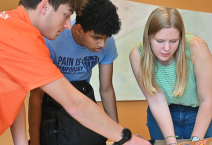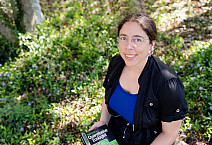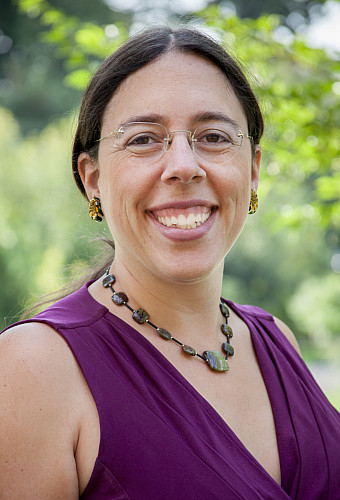Leslie New
Dr New graduated from Cornell University (BS in Natural Resources, 2003) and the University of St Andrews (PhD in Statistical Ecology, 2010). She remained at St Andrews as a post-doctoral fellow, before continuing her research with the US Marine Mammal Commission and US Geological Survey.
She is an applied statistician whose research is aimed at addressing questions of ecological interest, often from both an empirical and management perspective. Her work on evaluating the population consequences of disturbance has focused on quantitatively assessing how observed short-term changes in the individual behavior or physiology of marine mammals due to anthropogenic activities may led to long-term impacts on the effected population. In addition, Dr. New has worked to better understand the risk operating wind turbines pose to bird and bat species, and how to estimate and predict the effects wind facilities will have on wildlife populations.
From a statistical perspective, Dr. New’s research has sought to fully incorporate uncertainty into management and conservation decisions and to develop the statistical tools required to analyze the data collected from innovative technology, such devices intended to deter birds and bats from colliding with wind turbines.
Fun Fact: Dr. New volunteers with the 501st Legion, a Star Wars cosplay organization that supports and raises money for charities around the world.
Department
Degrees
- BS in Natural Resources, Cornell University
- Ph.D in Statistical Ecology, University of St Andrews
- Post-doctoral Fellow, University of St Andrews
Teaching
STAT 140 - Statistical Reasoning
STAT 141 - Statistics I
STAT 142 - R Lab
STAT 243 - Biostatistics
STAT 342 - Applied Regression Models
STAT 443 - Statistical Modelling
MATH 341 - Probability
MATH 442 - Mathematical Statistics
CIE 100 - Common Intellectual Experience
Research Interests
- Statistical ecology
- State-space and hidden Markov models
- Bayesian statistics
- Population consequences of disturbance
Recent Work
Publications:
Fernandez Ajó, A., Buck, C.L., Hunt, K., Pirotta, E., New, L., Dillion, D., Hildebrand, L., Beirlich, K.C., Bird, C. and Torres, L. (2025) Variation in fecal testosterone levels in male gray whales on a foraging ground relative to maturity and timing. Conservation Physiology, 13: coae094. doi.org/10.1093/conphys/coae094
Reed, J., Corkeron, P., New, L. and Harcourt, R. (2024) Breaking down abundance to understand conservation for small populations: A case study of North Atlantic right whales. Conservation Science and Practice, 6: e13263. doi.org/10.1111/csp2.13263
Colson, K.M., Pirotta, E., New, L., Cade, D.E., Calambokidis, J., Bierlich, K.C., Bird, C.N., Fernandez Ajó, A., Hildebrand, L., Trites, A.W. and Torres, L.G. (2024) Using biologging tags to quantify gray whale foraging behavior. Marine Mammal Science. doi.org/10.1111/mms.13210
Bird, C., Pirotta, E., New, L., Beirlich, K.C., Hildebrand, L., Fernandez Ajó, A., Torres, L. (2024) Bubble blasts! An adaption for buoyancy regulation in shallow foraging gray whales. Ecology and Evolution, 14: e70093. doi.org/10.1002/ece3.70093
Bird, C., Pirotta, E., New, L., Bierlich, K.C., Donnelly, M., Hildebrand, L., Fernandez Ajó, A., Torres, L. (2024) Growing into it: Evidence of an ontogenetic shift in gray whale use of foraging tactics. Animal Behaviour, 214: 121-135.
Pirotta, E., Beirlich, K.C., New, L., Hildebrand, L., Bird, C.N., Fernandez Ajó, A. and Torres, L.G. (2024) Modelling individual growth reveals decreasing gray whale body length and correlations with ocean climate indices at multiple scales. Global Climate Change Biology, doi.org/10.111/gcb.17366
Silva, M., Oliveira, C., Prieto, R., Silva, M., New, L. and Pérez-Jorge, S. (2024) Bioenergetic modelling of a marine top predator’s responses to changes in prey structure. Ecology and Evolution, 14: e11135. doi.org/10.1002/ece3.11135
Reed, J., New, L., Corkeron, P. and Harcourt, R. (2024) Disentangling the influence of entanglement on recruitment in North Atlantic right whales. Proceedings of the Royal Society B, 291. doi.org/10.1098/rspb.2024.0314
Pirotta, E., Fernandez Ajó, A., Bierlich, K.C., Bird, C., Buck, L., Haver, S., Haxel, J., Hildebrand, L., Hunt, K., Lemos, L.S., New, L, Torres, L. (2023) Developing physiological dose-response functions for gray whales exposed to anthropogenic stressors. Conservation Physiology, 11. doi.org/10.1093/conphys/coad082
Harrison, J., Ferguson, M., New, L., Cleary, J., Curtice, C., DeLand, S., Fujioka, E., Halpin, P., Moore, R.B.T., Van Parijs, S. (2023) Biologically important areas for cetaceans within U.S. and adjacent waters: Updates and an application of a new scoring system. (2023) Frontiers in Marine science, 10:1081893. doi.org/10.3389/fmars.2023.1081893
Presentations:
25th Biennial Conference on the Biology of Marine Mammals, Perth, Australia (2024): Speed talk: Modeling bowhead whale responses to changing ecological regimes via investigation of stress, growth and reproduction
Joint meeting of Statistical Ecology and Environmental Monitoring and the International Biometric Society Biometrics in the Bay of Islands, Waitangi, New Zealand (2023): Oral presentation: Species distribution models for eagle use in the continental United States.
International Conference on Advances in Interdisciplinary Statistics and Combinatorics, Greensboro, NC (2022): Oral presentation: “Balancing wind energy production and bat fatalities”
24th Biennial Conference on the Biology of Marine Mammals, Palm Beach, FL (2022): co-author on oral presentation: “Listening to mothers: modeling the true reproductive states of individual female right whales provides new insights into their decline”
International Statistical Ecology Conference, Cape Town, South Africa (2022): Co-author oral presentation: “Using a Bayesian multi-state mark-recapture model to assess cost of first reproduction and influence of entanglement on recruitment in female North Atlantic right whales”
Science Communication:
Ted Talk, Ted x Ursinus College (2023): “The Mathematics of Ecology” https://www.youtube.com/watch?v=ZPagoo7MQow
Podcast, Marine Conservation Happy Hour (2020): “Explaining Statistics using Star Wars” https://tinyurl.com/y3qdhu5q
Podcast, Marine Conservation Happy Hour (2020): “Inspiration through Stats in Marine Biology with Dr. Leslie New” https://tinyurl.com/yy46qc6y
Podcast, Marine Conservation Happy Hour (2020): “How Dr. Leslie New went from Remedial Math to Earn a PhD in Statistics and Now Works on Calculating the Effects of Underwater Noise on Marine Mammals” https://tinyurl.com/y53g76tm
Podcast, Marine Mammal Science (2020): “Why Statistical Ecology is So Cool” https://tinyurl.com/y2orrsgs




